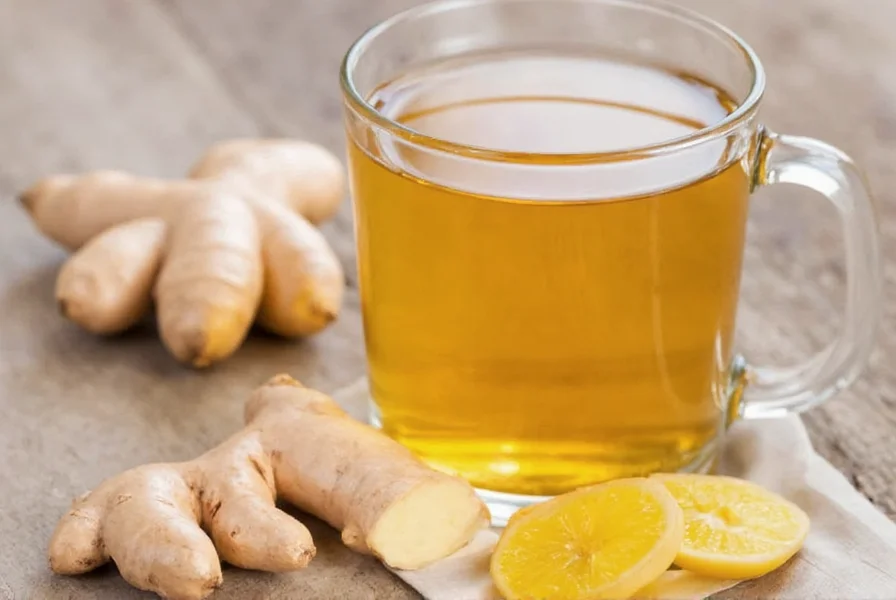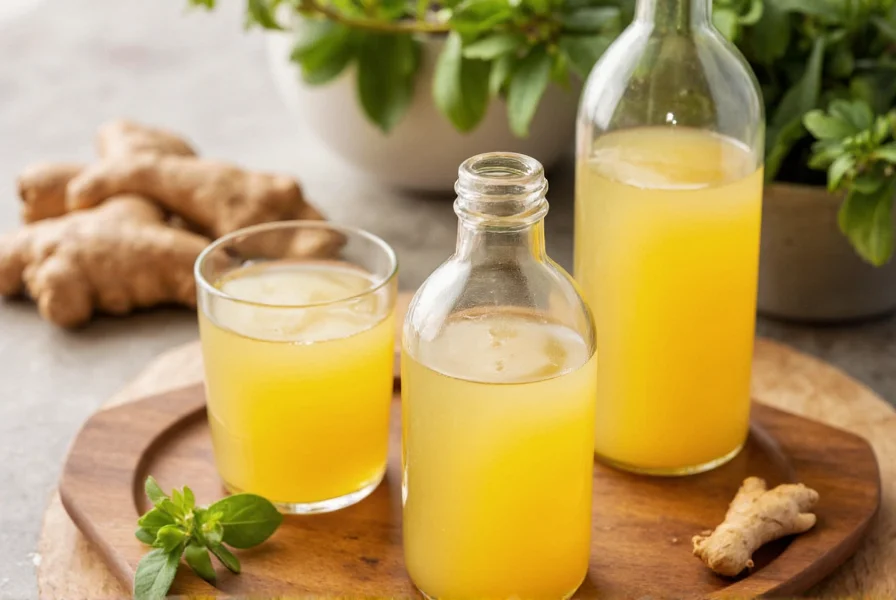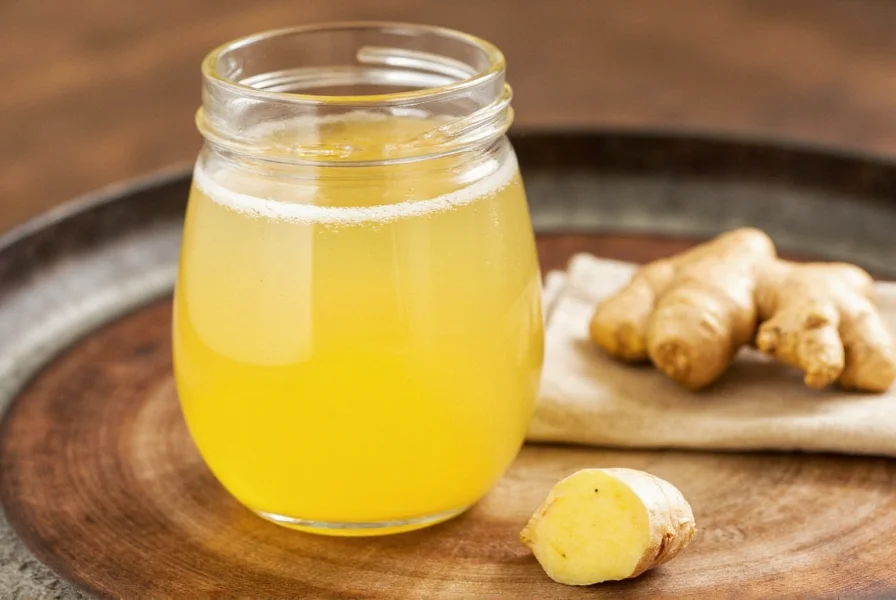Liquid ginger offers a potent, shelf-stable alternative to fresh ginger root with consistent flavor intensity and bioactive compound concentration. This versatile preparation maintains ginger's signature pungency while providing precise dosing capabilities impossible with fresh rhizomes. Unlike powdered ginger which loses volatile compounds during drying, liquid extracts retain more of ginger's thermogenic and anti-inflammatory properties through solvent-based extraction.
Understanding Liquid Ginger Composition
Liquid ginger products primarily fall into two categories: tinctures and extracts. Tinctures use alcohol (typically 40-90% ethanol) as a solvent to draw out gingerols and shogaols, while glycerin-based extracts provide alcohol-free alternatives. The extraction process significantly impacts potency—ethanol extracts typically contain 2-4% gingerols compared to fresh ginger's 1-2% concentration.
| Preparation Type | Solvent Used | Gingerol Concentration | Shelf Life |
|---|---|---|---|
| Alcohol Tincture | 40-90% ethanol | 2-4% | 3-5 years |
| Glycerin Extract | Vegetable glycerin | 1.5-3% | 1-2 years |
| Vinegar Extract | Apple cider vinegar | 1-2.5% | 6-12 months |
Practical Applications in Culinary and Wellness
Chefs prefer liquid ginger for consistent flavor in sauces, marinades, and baked goods where fresh ginger's fibrous texture would be undesirable. The concentrated nature allows precise flavor control—just 1/4 teaspoon of liquid ginger equals approximately 1 tablespoon of freshly grated root. Beverage makers increasingly use liquid ginger in craft sodas and functional drinks due to its immediate solubility.
For digestive health support, liquid ginger extract provides faster absorption than whole ginger. Research indicates that the bioavailability of 6-gingerol increases by 30-40% in liquid extract form compared to raw consumption. Many users report reduced nausea symptoms within 15 minutes when taking liquid ginger supplements, versus 30-45 minutes with fresh preparations.

Selecting Quality Liquid Ginger Products
When evaluating commercial liquid ginger products, check for these quality indicators:
- Transparent labeling of ginger-to-solvent ratio (look for 1:2 or 1:3 ratios indicating higher concentration)
- Organic certification to avoid pesticide residues in the extraction process
- Third-party testing documentation for heavy metals and microbial contaminants
- Alcohol-based extracts should specify ethanol percentage (higher concentrations preserve more volatile compounds)
Avoid products listing "natural flavors" or unspecified "ginger compounds"—these often contain diluted extracts with added flavor enhancers. Reputable manufacturers will disclose extraction methods and standardization percentages for key compounds like 6-gingerol.
Creating Homemade Liquid Ginger Extract
For those preferring DIY solutions, making liquid ginger at home ensures purity and customization. The cold-process method preserves maximum enzymatic activity:
- Peel and finely grate 4 ounces of organic ginger root
- Combine with 16 ounces of 80-100 proof vodka in a glass jar
- Store in a dark place for 4-6 weeks, shaking daily
- Strain through cheesecloth, squeezing to extract all liquid
- Store in amber glass dropper bottles away from light
This homemade liquid ginger extract maintains potency for 2-3 years when properly stored. For alcohol-free versions, substitute vegetable glycerin but expect slightly lower extraction efficiency of lipophilic compounds.

Safety Considerations and Usage Guidelines
Liquid ginger concentrate requires careful dosing due to its potency. The generally recognized safe intake is 1-2 mL (20-40 drops) daily for adults, equivalent to 2-4 grams of fresh ginger. Higher doses may cause gastric irritation, particularly in sensitive individuals. Those taking blood thinners should consult healthcare providers before regular consumption, as ginger may enhance anticoagulant effects.
Proper storage maintains liquid ginger's efficacy—keep bottles tightly sealed in cool, dark places. Alcohol-based extracts rarely spoil but may lose potency over time, while glycerin-based versions should be refrigerated after opening. Always check for cloudiness or off-odors which indicate contamination.
Comparing Liquid Ginger to Other Forms
Liquid ginger offers distinct advantages over powdered and fresh forms in specific applications. While fresh ginger provides textural elements and immediate aromatic compounds, liquid extracts deliver standardized potency and longer shelf stability. Powdered ginger loses 30-50% of volatile oils during processing, making liquid forms superior for therapeutic applications requiring consistent dosing.
Culinary professionals increasingly choose liquid ginger for recipe standardization in commercial kitchens, where fresh ginger's variable moisture content and potency create inconsistency. The concentrated nature also makes liquid ginger ideal for travel and emergency kits where space and weight matter.
Practical Integration into Daily Routines
Adding liquid ginger to morning beverages provides gentle digestive stimulation. Try 10-15 drops in warm lemon water before breakfast to support healthy digestion. For post-exercise recovery, mix 20 drops with electrolyte water to leverage ginger's anti-inflammatory properties. The precise dropper format makes it easy to incorporate into smoothies, salad dressings, and even homemade skincare formulations seeking ginger's antioxidant benefits.
What's the difference between liquid ginger and ginger extract?
Liquid ginger typically refers to ginger steeped in a solvent like alcohol or glycerin, while ginger extract indicates a more concentrated preparation where ginger compounds have been isolated. Most commercial "liquid ginger" products are actually tinctures with 1:2 to 1:5 ginger-to-solvent ratios, containing 1-4% gingerols compared to fresh ginger's 1-2% concentration.
How much liquid ginger equals fresh ginger in recipes?
The standard conversion is 1/4 teaspoon of liquid ginger extract equals 1 tablespoon of freshly grated ginger. This ratio accounts for the concentration difference, though potency varies between brands. When substituting in recipes, start with half the recommended amount and adjust to taste, as liquid forms distribute more evenly than fresh grated ginger.
Can liquid ginger help with nausea relief?
Yes, liquid ginger extract provides faster nausea relief than fresh ginger due to higher bioavailability of active compounds. Clinical studies show that 1-2 mL (20-40 drops) of standardized liquid ginger taken at nausea onset reduces symptoms within 15-20 minutes. The concentrated form allows precise dosing critical for managing pregnancy-related or chemotherapy-induced nausea.
Does liquid ginger lose potency over time?
Alcohol-based liquid ginger maintains potency for 3-5 years when stored properly in dark glass containers away from heat and light. Glycerin-based extracts last 1-2 years before noticeable degradation. Signs of potency loss include diminished aroma, color fading from golden to pale yellow, and reduced pungency. Always check manufacturer's expiration dates and store in cool, dark places to maximize shelf life.
Is liquid ginger safe for children?
Liquid ginger requires careful dosing for children. Pediatric guidelines suggest no more than 0.5 mL (10 drops) daily for children aged 6-12, diluted in water or juice. Alcohol-based extracts aren't recommended for children under 12—choose glycerin-based alternatives instead. Always consult a pediatrician before giving liquid ginger to children, especially for therapeutic purposes, as ginger may interact with certain medications.
Final Considerations for Liquid Ginger Use
Liquid ginger represents a valuable preparation method that maximizes ginger's functional properties while addressing practical limitations of fresh and powdered forms. Its concentrated nature provides consistent dosing for both culinary precision and wellness applications. When selecting products, prioritize transparency in extraction methods and standardization of active compounds to ensure you receive the full spectrum of ginger's benefits. Proper storage and measured usage will help you safely incorporate this versatile ingredient into daily health and cooking routines.











 浙公网安备
33010002000092号
浙公网安备
33010002000092号 浙B2-20120091-4
浙B2-20120091-4